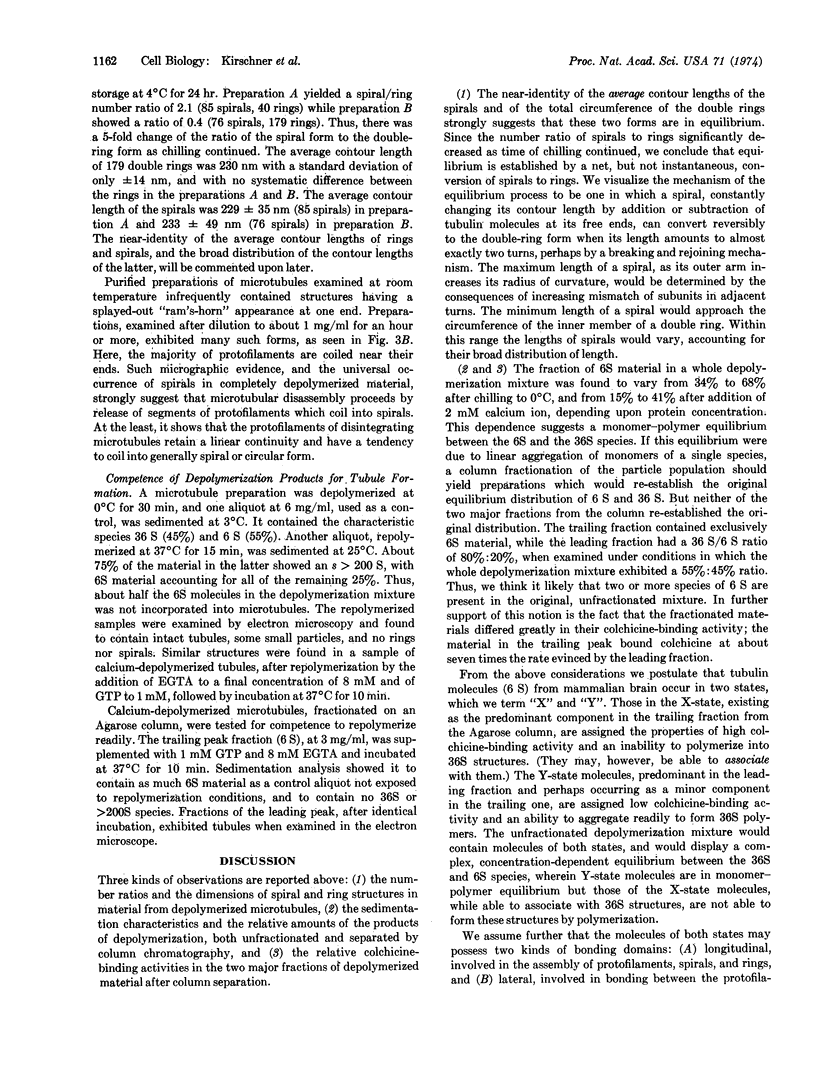Abstract
Depolymerization products of purified microtubules from porcine brain were examined by sedimentation analysis and electron microscopy. The complete depolymerization mixture exhibited 36S and 6S components in concentration-dependent equilibrium, whether depolymerization was caused by low temperature or by calcium ion. These components were recognized by electron microscopy as spirals and rings, and small particles. Agarose column chromatography yielded two major fractions, a leading one comprising mostly 36S and some 6S material and a trailing one of solely 6S material. The latter had high specific colchicine-binding activity and no tendency to polymerize. For the leading peak material these properties were the converse. It is proposed that tubulin molecules (of mass 110,000 daltons) exist in two states, here called X and Y, with those of the X-state equivalent to the material found predominantly in the trailing fraction, and those of the Y-state equated with the material in the leading fraction. Participation of tubulin molecules in microtubule assembly and disassembly is discussed, based on the assumption that those of both states have longitudinal and lateral binding domains whose strengths differentially depend upon temperature and calcium-ion concentration.
Keywords: electron microscopy, sedimentation analysis, protofilaments, tubulin, colchicine
Full text
PDF




Images in this article
Selected References
These references are in PubMed. This may not be the complete list of references from this article.
- Borisy G. G., Olmsted J. B. Nucleated assembly of microtubules in porcine brain extracts. Science. 1972 Sep 29;177(4055):1196–1197. doi: 10.1126/science.177.4055.1196. [DOI] [PubMed] [Google Scholar]
- Bryan J., Wilson L. Are cytoplasmic microtubules heteropolymers? Proc Natl Acad Sci U S A. 1971 Aug;68(8):1762–1766. doi: 10.1073/pnas.68.8.1762. [DOI] [PMC free article] [PubMed] [Google Scholar]
- Inoué S., Sato H. Cell motility by labile association of molecules. The nature of mitotic spindle fibers and their role in chromosome movement. J Gen Physiol. 1967 Jul;50(6 Suppl):259–292. [PMC free article] [PubMed] [Google Scholar]
- Olmsted J. B., Borisy G. G. Microtubules. Annu Rev Biochem. 1973;42:507–540. doi: 10.1146/annurev.bi.42.070173.002451. [DOI] [PubMed] [Google Scholar]
- Shelanski M. L., Gaskin F., Cantor C. R. Microtubule assembly in the absence of added nucleotides. Proc Natl Acad Sci U S A. 1973 Mar;70(3):765–768. doi: 10.1073/pnas.70.3.765. [DOI] [PMC free article] [PubMed] [Google Scholar]
- Weisenberg R. C., Borisy G. G., Taylor E. W. The colchicine-binding protein of mammalian brain and its relation to microtubules. Biochemistry. 1968 Dec;7(12):4466–4479. doi: 10.1021/bi00852a043. [DOI] [PubMed] [Google Scholar]
- Weisenberg R. C. Microtubule formation in vitro in solutions containing low calcium concentrations. Science. 1972 Sep 22;177(4054):1104–1105. doi: 10.1126/science.177.4054.1104. [DOI] [PubMed] [Google Scholar]
- Wilson L. Properties of colchicine binding protein from chick embryo brain. Interactions with vinca alkaloids and podophyllotoxin. Biochemistry. 1970 Dec 8;9(25):4999–5007. doi: 10.1021/bi00827a026. [DOI] [PubMed] [Google Scholar]





